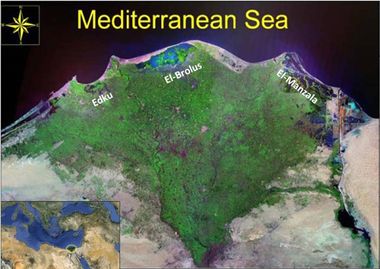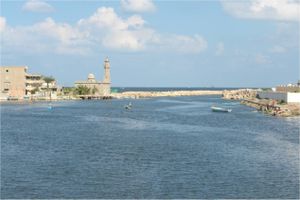Difference between revisions of "Nile Delta"
| (17 intermediate revisions by 5 users not shown) | |||
| Line 1: | Line 1: | ||
[[Image: Nile_delta_map.jpg|380px|thumb|left]] | [[Image: Nile_delta_map.jpg|380px|thumb|left]] | ||
| + | |||
| + | |||
<u>'''CASE description'''</u> | <u>'''CASE description'''</u> | ||
| − | The CASE is characterised by a fluvio-marine delta, a low lying coast with lagoon and wetlands (Idku and El- Brulus), its coastal length is about 180 km. The Delta is composed of 7 main administrative units (Governorates). Almost 14 million person residents are situated at the narrow strip around the Nile River. Prevailing land/sea uses are: agriculture tourism, fisheries, industry, maritime and Oil and gas exploration. | + | The CASE is characterised by a fluvio-marine [[Wave-dominated river deltas|delta]], a low lying coast with lagoon and wetlands (Idku and El- Brulus), its coastal length is about 180 km. The Delta is composed of 7 main administrative units (Governorates). Almost 14 million person residents are situated at the narrow strip around the Nile River. Prevailing land/sea uses are: agriculture tourism, fisheries, industry, maritime and Oil and gas exploration. |
| + | |||
| + | [[Image:Nile_delta_map_2.jpg|300px|thumb|right|]] | ||
| − | |||
<u>'''ICZM phase'''</u> | <u>'''ICZM phase'''</u> | ||
| − | Establishment | + | [[ICZM_Process_diagram/Establishment|Establishment]] |
| + | |||
| + | |||
| Line 18: | Line 23: | ||
- Land use | - Land use | ||
| + | |||
| Line 29: | Line 35: | ||
- To develop planning options for decision makers | - To develop planning options for decision makers | ||
| − | + | <br style="clear:both;"/> | |
| − | |||
[[image: Nile_delta.jpg|300px|thumb|left|Idku lake (Author: Suzan Kholeif)]] | [[image: Nile_delta.jpg|300px|thumb|left|Idku lake (Author: Suzan Kholeif)]] | ||
| − | |||
<u>'''End Products'''</u> | <u>'''End Products'''</u> | ||
| Line 47: | Line 51: | ||
<u>'''Tools foreseen to be developed and used'''</u> | <u>'''Tools foreseen to be developed and used'''</u> | ||
| − | Indicators - LEAC - Scenarios - Participatory methods | + | Indicators - LEAC - Scenarios - [[Participation in the Nile Delta|Participatory methods]] |
| + | |||
| + | |||
<u>'''Training needs'''</u> | <u>'''Training needs'''</u> | ||
LEAC - Scenarios - Participatory methods | LEAC - Scenarios - Participatory methods | ||
| + | <br style="clear:both;"/> | ||
| − | |||
<u>'''CASE Responsible'''</u> | <u>'''CASE Responsible'''</u> | ||
Susan Kholeif - National Institute of Oceanography and Fisheries - Suzan_Kholeif@yahoo.com | Susan Kholeif - National Institute of Oceanography and Fisheries - Suzan_Kholeif@yahoo.com | ||
| + | |||
| + | |||
| + | <span style="color: Blue"><small>Elaboration: Stefano Soriani, Fabrizia Buono, Monica Camuffo, Marco Tonino, University Ca’ Foscari of Venice.</small></span> | ||
| + | [[Category:PEGASO study sites]] | ||
Latest revision as of 14:20, 29 August 2016
CASE description
The CASE is characterised by a fluvio-marine delta, a low lying coast with lagoon and wetlands (Idku and El- Brulus), its coastal length is about 180 km. The Delta is composed of 7 main administrative units (Governorates). Almost 14 million person residents are situated at the narrow strip around the Nile River. Prevailing land/sea uses are: agriculture tourism, fisheries, industry, maritime and Oil and gas exploration.
ICZM phase
Main coastal issues
- Fishery
- Climate change effects such as erosion
- Land use
Objectives
- To develop adaptation strategies to climate change
- To increase fishermen well-being
- To develop planning options for decision makers
End Products
Plans-strategic vision-strategy and organisational design, with respect to:
- adaptation policy
- support of local communities in designing-implementing local development plans with particular reference to fishery and mariculture.
Tools foreseen to be developed and used
Indicators - LEAC - Scenarios - Participatory methods
Training needs
LEAC - Scenarios - Participatory methods
CASE Responsible
Susan Kholeif - National Institute of Oceanography and Fisheries - Suzan_Kholeif@yahoo.com
Elaboration: Stefano Soriani, Fabrizia Buono, Monica Camuffo, Marco Tonino, University Ca’ Foscari of Venice.


